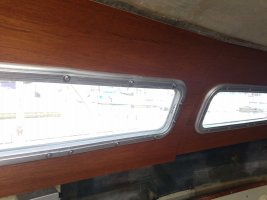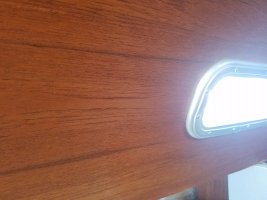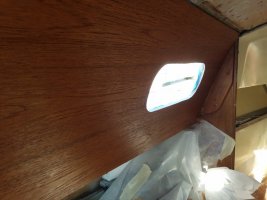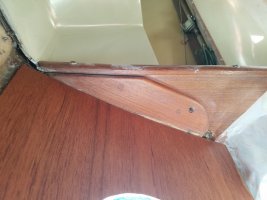Adding some photos as a resource to point other threads to so other owners understand what they are getting into.
Leaking ports (fixed and opening) are the subjects of other threads to search for, but when the teak is bubbled this extensively it's past putting another layer over it and time to strip and replace the veneer. Note the black mold where leaks had been between the aluminum and sidewall.

For those thinking to just seal the glass to the rubber, it won't last and here is the result. The new silicone doesn't like to stick to the black silicone rubber seals.

With a port light out and before cleaning off the leaking old caulk, you can see that the structure is solid. From 0 - 1/4" is structure and 1/4" to 1/2" is teak. (There's a blue tarp outside)

Newspaper test (simply put water on the window) showed how bad these fixed frames leaked to the glass. There are threads discussing the options of glass vs plastic for window material and bedding the glass with either sealant (Life Caulk or others) or new rubber sold for Catalina 30s.

The opening BOMARs had leaked so long the metal had eroded so those needed to be replaced. Christian Williams and others have posted threads about what is needed to replace them with the slightly larger Lewmars.
Cutting out the teak and replacing it is a major job of cutting the edges of the material to be replaced and grinding teak off fiberglass. You will find that the fiberglass is very uneven beneath the teak with large voids.

The headliner is stapled to to the teak so I cut along the edge and this transition can be hidden by the wood trim strip which comes off.

Glue on the new veneer and install the new port lights.
Leaking ports (fixed and opening) are the subjects of other threads to search for, but when the teak is bubbled this extensively it's past putting another layer over it and time to strip and replace the veneer. Note the black mold where leaks had been between the aluminum and sidewall.

For those thinking to just seal the glass to the rubber, it won't last and here is the result. The new silicone doesn't like to stick to the black silicone rubber seals.

With a port light out and before cleaning off the leaking old caulk, you can see that the structure is solid. From 0 - 1/4" is structure and 1/4" to 1/2" is teak. (There's a blue tarp outside)

Newspaper test (simply put water on the window) showed how bad these fixed frames leaked to the glass. There are threads discussing the options of glass vs plastic for window material and bedding the glass with either sealant (Life Caulk or others) or new rubber sold for Catalina 30s.

The opening BOMARs had leaked so long the metal had eroded so those needed to be replaced. Christian Williams and others have posted threads about what is needed to replace them with the slightly larger Lewmars.
Cutting out the teak and replacing it is a major job of cutting the edges of the material to be replaced and grinding teak off fiberglass. You will find that the fiberglass is very uneven beneath the teak with large voids.

The headliner is stapled to to the teak so I cut along the edge and this transition can be hidden by the wood trim strip which comes off.

Glue on the new veneer and install the new port lights.
Last edited:







